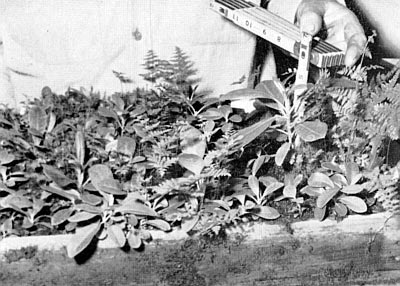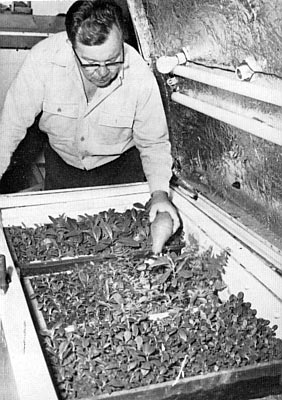Raising Seedlings With Help From Mother Nature
Henry R. Yates, Frostburg, Md.
I have read with much interest the papers published in the American Rhododendron Society Bulletins on the raising of rhododendron seedlings. These methods are quite diverse and all are very interesting.
As I seem to have a different approach in some respects and have met with some success, it would seem that some of the things I am doing must be right; therefore, 1 have been asked by a number of members to divulge my favorite recipe.

|
|
Fig. 53. Seedlings 5 months from seed. The ferns
happened to be in the moss mixture. |
I have been experimenting for the past twelve years using fluorescent lights in growing chambers of the Glenn Dale Propagator type. Since my methods of lighting are not too different from the standard procedure, we will not dwell on that aspect in this article, and will only mention pertinent facts. It is in the growing medium that I am accused of leaning to the far left. While most growers would be horrified at the thought of using anything but sterilized sphagnum, I purposely contaminate my flats. Credit must be given Mr. Guy Nearing, of Ramsey, New Jersey, for the original idea behind my experiments with mosses. In the October, 1957, issue of the ARS Bulletin, Mr. Nearing wrote the paper entitled, "Nature Can Protect Small Seedlings."
He stated that mosses contain an antibiotic substance that protects the small seedlings against most fungi, especially the deadly
Pythium debaryanum
. This article was of such interest to me (an organic nut) that I began a series of experiments using these mosses in various manners.
After several years of trial, I finally settled on the following procedure. First, let me state I am not a moss expert and know not the names of the various kinds. I have not found the choice of moss to be of much importance except I prefer using the low growing kinds that will not overgrow the tiny seedlings. After gathering the necessary moss in a nearby woods, I grind the dampened material through a meat grinder. (Mr. Joseph B. Gable of Stewartstown, Pennsylvania, kindly donated me his father's old sausage grinder.) This produces a very fine material that resembles snuff. This is mixed-three parts moss to one of sandy woods soil to be spread in a thin layer over the planting mixture that consists of one part German peat, one part clay loam, one leaf mold, one sandy wood soil. This is rubbed through a one-fourth inch screen.
Moss Over Sterilized Medium
I do sterilize this part of the medium to get rid of the bugs, worms, and weed seeds. After filling my flats with this mixture, I press it down firmly with a brick to leave about three-quarters inch clearance from the top of the flat. On top of this the icing of un-sterilized moss and soil mixture is spread about one-fourth inch deep and firmed slightly. The flats are then placed in a shallow container of water and allowed to become thoroughly saturated. The seeds are then sown very carefully on top of the moss with no covering except a pane of glass over each flat. This should be all the water required for some time, almost until germination has taken place-about three weeks average time. Some germinate in eleven days and this year some seed of
R. yakushimanum
FCC. selfed took about ninety days.
I have found after experimenting with Gro Lux lamps that their use over the seed flats seems to incite better and faster germination. However, after the seedlings have started to grow a mixture of lamps such as one cool white, warm white, and a Gro Lux seem to produce the sturdiest plants.
There are two plant boxes in use in my basement where the average winter temperature is about sixty degrees. These boxes are constructed with a hinged top or lid in which a three tube fluorescent fixture is mounted over the flats. The heat generated by these fixtures is enough to maintain the desired temperature. Heat and humidity can be controlled by leaving the lid closed completely for more heat and humidity, or by opening it the desired amount to lower the heat and humidity. By this adjustment temperature can be regulated to be about 76 to 78 degrees at 10:30 p.m. when the timer is set to turn off the lights and slowly drop to 66 to 68 degrees when the lights are switched back on, almost like our natural summertime temperature. The fifteen hours of light supplied seems to be enough to stimulate rapid growth.

|
|
Fig. 54. Plants growing in a discarded 14'
refrigerator placed on its back on 4 cement blocks. Lights were in- stalled in the door shell. |
Seeds Sown in December
The seeds are sown the first week of December so that by the middle of April they are good sturdy seedlings ready for transplanting into pots, the smaller ones into two inch pots with many of the huskier plants requiring three or four inch pots. Anyone trying this method will have quite a surprise awaiting them when in about two weeks after seeding time they notice the tops of the flats beginning to turn a beautiful emerald green. (Do not be alarmed as this is the very thing we want to happen.) It is the moss mixture starting to grow and furnish the protection from damp off, which our little plants need.
As soon as germination is well advanced the glass is removed. At this stage careful watering is a requisite, and I look in at least once a day to be sure they don't dry out. Watering is done sometime early in the day to give the seedlings time to dry off before the lights go off. Eighty degree water is sprayed over the seedlings using a fine spray-Centeo spray bulb-and may I add,
easy does it
. After most of the seedlings have germinated I begin using Liquid Whale about three times a week. A very dilute solution of one-half teaspoon to a gallon of water brings the plants along at a very rapid rate and hasn't yet caused any trouble from burning by over fertilizing.
It has been stated many times that hybrids of
R. griersonianum
are very sensitive to fertilizers. I have found this to be true even in very small seedlings. The noticeable effect is a distortion and curling of the leaves. However, as the plants are potted up and go into their second year they seem to outgrow this malformation. After potting up the seedlings and danger of frost is passed, the pots are plunged in a bed of peat under a small lath house. They remain there until the following spring.
Tender Seedlings Eliminated
Since we live on Big Savage Mountain, the coldest spot in Maryland, hardiness must be my goal. My crosses are made with this in mind. Our temperature occasionally drops to 20 degrees below zero or lower. The seedlings are given no protection after moving them outdoors. If they can not take it, the quicker they are eliminated the better it pleases me.
I have grown thousands of seedlings, using the above methods, for both myself and Mr. Gable, who says they are
super
seedlings and probably cut a year off the time normally required for a seedling to flower. I hope I have covered the important points in this method, but would like to stress once more the importance of careful attention to the temperature and most important the proper watering. I would like to add that possibly the most important ingredient of any gardener's supplies is T. L. C.*
* Tender Loving Care.